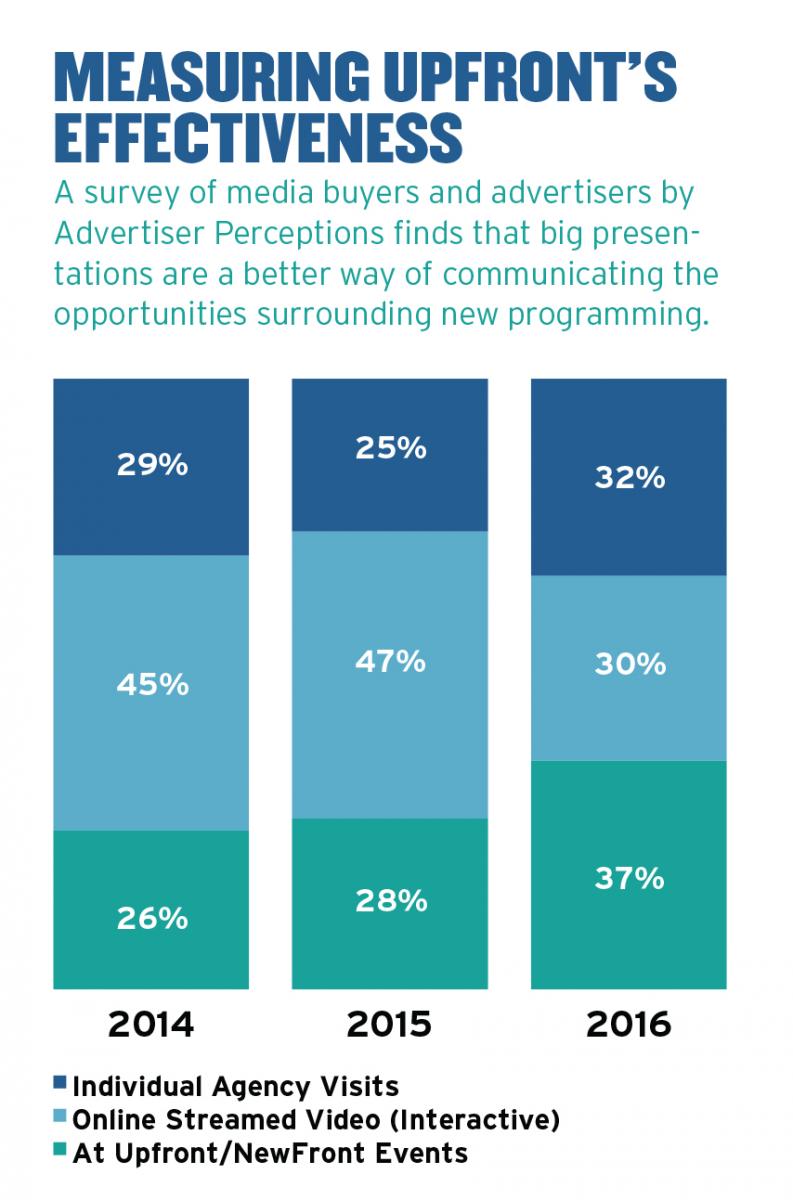Upfronts More Vital As Video Gets Complex

This year’s upfront not only marked a comeback in terms of spending growth, but also reinforced the importance of an institution that not long ago appeared becoming obsolete.
For years buyer questioned the necessity of attending the celebrity-studded programming presentations each spring, and the shrimp-happy parties that followed. The networks similarly wondered if there was a less expensive way of getting information about new season programming to clients.
But according to a new survey by Advertiser Perceptions of media buyers and marketers, the percentage of those calling upfronts and NewFronts the most effective method for delivering programming information is on the rise.
Advertiser Perceptions found that those preferring upfront presentations to individual visits or interactive online presentation reached 37% in 2016, up from 28% in 2015 and 26% in 2014.
Randy Cohen, president of Advertiser Perceptions, which works with many of the largest TV networks, says that change in attitude among clients might be the result of networks doing a better job of adapting to a changing media environment.
Cohen notes that as recently as three or four years ago, TV networks saw no need to change the way they’d done business for decades.
“A lot of television networks, both broadcast and cable, were seeing all the stuff that was going on around them, lots of digital spending, the growth of YouTube, but they felt those things were different from what they did, and therefore they were going to do what they always did,” he said. “They had digital video assets, but those amounted to a rounding error, so those were sold separately.”
Broadcasting & Cable Newsletter
The smarter way to stay on top of broadcasting and cable industry. Sign up below
Cohen says they “woke up two years ago at the upfronts saying, ‘Holy s---, the market’s changing and we need to refocus and repackage and rebrand,’ and in some cases put things together that historically weren’t.”
Since then, media companies such as NBC and Fox started unifying their broadcast, cable and digital ad sales teams in order to better deal with marketers and buyers, who were starting to look at video in a more holistic way.
With the video market becoming more complex, more marketers and buyers felt they must attend upfront presentations.
“They’re also listening differently. It’s no longer just about what’s the hit show and what’s the big thing but where’s your road map, what’s your strategy on data, what’s your strategy on all the things that they’re hearing and feeling with their own customer bases,” Cohen said. “To me it’s almost back to where it was in terms of importance. And I wouldn’t have said that two or three year ago.”
Cohen says that some of the optimism in the market comes because rather than focusing on ratings, which are still going down, they’re looking at audiences that tend to buy specific products.
“It’s not so much about shows and ratings. It’s more around the amalgam or creation of better audiences so that I can target and reach where consumers are. I think it took a while for that to happen, but this is the first year at the upfront where we’re actually seeing it,” he said.
That newfound optimism shows up in Advertisers Perceptions’ surveys.

The percentage of buyers and advertisers saying they’re “getting good value for TV money spent” was at 80% for 2016. And when asked “Are TV brands providing enough digital content opportunities and managing the multimedia process well?” 70% said yes, with 30% answering no.
The hot upfront naturally will have consequences for markets in the future. When asked if overall strong media sales hurt the scatter market, 55% said yes, with 45% saying no. And 75% said that heavily increased CPMs hinder the ability to maintain or increase TV buys moving forward.
But there was one figure that Cohen said put a scare into him as an old agency hand. He said Advertiser Perceptions just did a pilot study that found that 58% of the top 200 spending brands are going to be reviewing their agency relationships in the next two years.
“That’s another reason why I think the upfronts are so important because everyone’s together at that point,” Cohen said. “It’s a great time to be a media company because they have a more direct connection with the marketers in terms of delivering the right audiences and [helping marketers achieve their goals] rather than having to go through a middleman.”
Jon has been business editor of Broadcasting+Cable since 2010. He focuses on revenue-generating activities, including advertising and distribution, as well as executive intrigue and merger and acquisition activity. Just about any story is fair game, if a dollar sign can make its way into the article. Before B+C, Jon covered the industry for TVWeek, Cable World, Electronic Media, Advertising Age and The New York Post. A native New Yorker, Jon is hiding in plain sight in the suburbs of Chicago.

